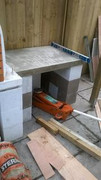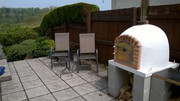iang
member

Posts: 10
|
Post by iang on Feb 9, 2019 9:26:29 GMT
Hello all,
Basically, will a regular patio bear the weight of a smallish oven or will it shift and destroy my project?
The patio has been there for 40 years and I'm hoping has done all the natural settling by now. I don't want to take up the patio up and cast a conspicuous rebar concrete base in case my oven doesn't work or ends up looking like a dog's dinner and I want to dismantle it in a few years only to be left with a massive concrete block that cannot be removed or paved over.
I was planning on a small 1.2 by 1.5m E-shaped plinth constructed from concrete blocks,which would be topped with 50mm council pavers. Aircrete blocks plus vermiculite for base insulation. I have obtained some storage heater bricks for the oven base. I'm wavering between a Pompeii and a barrel design but will be using solid engineering bricks in either case to keep costs low.
Crude calculations suggest all of the above is likely to weigh the best part of a tonne. I was planning to have the plinth positioned such that it transfers the load over 6 of the 60x60 patio slabs underneath but I'm still worried it may subside and collapse.
I originally planned to make the plinth out of thermolite blocks which would be easier to work with and would save about 300kg but I discovered yesterday that they are nearly impossible to render without them cracking. This is because they expand and contract hugely with environmental conditions.
So has anyone built directly on their patio? Am I being too cautious? Should I even can my project?
Also has anyone got experience of building their plinth out of thermolite blocks? Is this to be avoided?
Thanks a tonne in advance (did you see what I did there?!)
Ian
|
|
|
|
Post by simonh on Feb 9, 2019 14:21:16 GMT
It will entirely depend on how the patio has been laid I suspect. For example mine is natural slate with a 12” hardcore layer and a 2” full wet bed. I would be happy building direct onto that. It you have pavers straight onto sand I wouldn’t.
|
|
|
|
Post by devontiger on Feb 9, 2019 14:53:14 GMT
iang, can you post up a picture where you intend to build.
It sounds possible, but can you not add an extra base???
|
|
iang
member

Posts: 10
|
Post by iang on Feb 9, 2019 16:48:39 GMT
Thanks for the replies so far.
I took a couple of photos but unfortunately I can't find a means of attaching them to the thread for some reason.
The patio is built on sand-doubt there is hardcore etc underneath. The pavers are 50mm thick so should spread the load reasonably well but it is a hellofa load. Am not keen on laying a reinforced concrete slab unless it's absolutely necessary.
Has anybody had successes or failures building directly onto patio flags sitting on sand?
Cheers again
Ian
|
|
iang
member

Posts: 10
|
Post by iang on Feb 9, 2019 16:59:41 GMT
|
|
iang
member

Posts: 10
|
Post by iang on Feb 9, 2019 17:07:58 GMT
|
|
|
|
Post by devontiger on Feb 9, 2019 20:59:40 GMT
Personally I would build it up on hollow concrete blocks. These blocks spread the load well. I built mine dry, so you can play about a bit with the design. If the worst happens you can take it down & start again, or reinforce. If you go for a ready built oven, you'll be up & running as soon as your block-work is up. As long as you can get the oven into the rear.   |
|
|
|
Post by downunderdave on Feb 9, 2019 21:23:20 GMT
You won’t really know until you build it and use it for a few years. But most driveways made from pavers laid on sand end up dropping at least 10 mm over the years from the weight of a car which is around a ton with the load spread on four relatively small points. If the pavers all settle evenly it won’t damage your oven, but if say one corner drops more than the others the movement will probably work it’s way up resulting in cracking. A lot also depends on the size of the oven as volume increases by cubed. While floor area only by squared. Eg double the diameter increases the floor area 4 x and volume a whopping 16 x. Mass goes up with volume, not quite at the same rate because wall thickness usually remains the same for a small or large oven, but you get the idea. A cast modular oven will be lighter than the equivalent made from brick as they usually have walls 50 mm thick rather than 100 mm of the brick ovens.
|
|
iang
member

Posts: 10
|
Post by iang on Feb 11, 2019 21:25:49 GMT
Thanks for you thoughts guys. I "think" I'm going to take the risk and go for it. If nothing else it will be some more knowledge to feed back into the ukwoodfiredoven community.
|
|